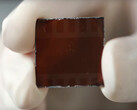Researchers have developed a self-heating concrete that could make large-scale snow clearing or salt spreading a thing of the past. The novel material which has been the subject of research at Drexel University in Philadelphia for five years, melts snow on roads and sidewalks for up to ten hours.
Snowy and icy roads slow down traffic and increase the risk of accidents by making manoeuvring more difficult. In the US alone, government agencies spend over $2.3 billion each year to combat snow and ice. Salt is often used for ice and snow removal, but this is harmful to the environment and can have a detrimental effect on the integrity of the road surface. For example, if melted ice seeps into the road, refreezes and expands, cracks can form. Repairing these and similar damages costs millions of dollars.
Secret ingredient: low-temperature liquid paraffin
The secret of the self-heating concrete lies in the addition of paraffin, a so-called phase-change material. At slightly warmer temperatures, the material is liquid and stores the heat energy from the air, but when it cools down, it becomes solid and releases the stored heat into the environment. The researchers are currently experimenting with two methods: In one, microcapsules of paraffin are mixed into the concrete; in the other, small stone fragments absorb the paraffin before being mixed into the concrete.
Preventing freezing and thawing and cutting back on the need for plowing and salting are good ways to keep the surface from deteriorating. So, our work is looking at how we can incorporate special materials in the concrete that help it to maintain a higher surface temperature when the ambient temperature around it drops.
- Amir Farnam, senior researcher at the Drexel Laboratory for Advanced Infrastructure Materials (AIM) and one of the authors of the study
The new material is not yet ready for large-scale use and further research is needed. For example, the performance of the phase-change material may be affected if it does not have enough time to warm up between frost and snow. In addition, the material is not yet suitable for very heavy snowfall.
We found that PCM-incorporated pavements cannot completely melt heavy snow accumulation — larger than 2 inches,” Deb said. “It can, however, melt snowfalls less than two inches quite effectively. The PCM-incorporated slabs begin melting snow as soon as it starts to accumulate. And the gradual heat release can effectively deice a pavement’s surface, which would eliminate the need to pre-salt before the heavy snowfall.
- Robin Deb, PhD student in the College of Engineering, who helped to lead the research
Are you a techie who knows how to write? Then join our Team! Wanted:
- News Writer
Details here
Source(s)
Drexel News | New Atlas | Researchgate | Teaser image: symbolic image by Dall-E / AI


 Deutsch
Deutsch English
English Español
Español Français
Français Italiano
Italiano Nederlands
Nederlands Polski
Polski Português
Português Русский
Русский Türkçe
Türkçe Svenska
Svenska Chinese
Chinese Magyar
Magyar











